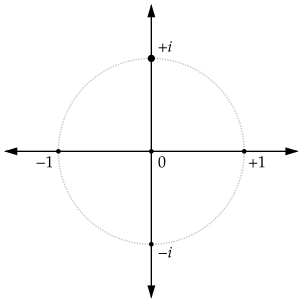−1 (number) facts for kids
Quick facts for kids −1 |
|||
|---|---|---|---|
|
List of numbers -- Integers (whole numbers) |
|||
| Cardinal | −1, minus one, negative one | ||
| Arabic | −١ | ||
| Chinese numeral | 负一,负弌,负壹 | ||
| Bengali | ô১ | ||
| Binary (byte) |
|
||
| Hex (byte) |
|
||
In mathematics, −1 is the additive inverse of 1. That is, if it is added to 1, the result is 0. It is the negative integer greater than negative two (−2) and less than 0.
Negative one has some similar properties as positive one. But some are different.
Negative one is related to Euler's identity. This is because the identity states 
In computer science, −1 is a common initial value for integers. It is also used to show that a variable has no useful information.
Contents
Algebraic properties
Multiplying a number by −1 is the same as changing the sign on the number. This can be proved using the distributive law and the axiom at 1 is the multiplicative identity, that is, a number multiplied by 1 is the number itself. So, for x real, we have
where we used the fact that 0 multiplied by any real number x equals 0, shown by cancellation from the equation
In other words,
so (−1) · x or −x is the arithmetic inverse of x.
Square of −1
The square of −1, i.e. −1 multiplied by −1, equals 1. So, a square of negative real numbers is positive.
To prove this with algebra, start with the equation
The first equality follows from the above result. The second follows from the definition of −1 as additive inverse of 1, that is, when added to 1, it gives 0. Now, using the distributive law, we see that
The second equality follows from the fact that 1 is a multiplicative identity, that is :  . But now adding 1 to both sides of this last equation means
. But now adding 1 to both sides of this last equation means
The above arguments hold in any ring. Ring is a concept of abstract algebra generalizing integers and real numbers.
Square roots of −1
The complex number i satisfies i2 = −1. So it is a square root of −1. The only other complex number x for which the equation x2 = −1 holds is −i. In the algebra of quaternions, which has the complex plane, the equation x2 = −1 has an infinity of solutions.
Exponentiation to negative integers
A non-zero real number can have a negative number as its power. We define that x−1 = 1/x. This means a number raised to a power of −1 is equal to the reciprocal of that number. The exponential law xaxb = x(a + b) for a,b non-zero real numbers is true even if a or b is negative.
Computer representation
There are many ways that −1 (and negative numbers in general) can be represented in computer systems. The most common is as two's complement of their positive form. In standard binary representation, this can also represent a positive integer.
See also
 In Spanish: Menos uno para niños
In Spanish: Menos uno para niños






![0 =-1\cdot 0 =-1\cdot [1+(-1)]](/images/math/9/6/5/9652c1e53be68a5c8d9764987ba960a2.png)
![0 =-1\cdot [1+(-1)]=-1\cdot1+(-1)\cdot(-1)=-1+(-1)\cdot(-1)](/images/math/1/d/2/1d285c708caa2574cd5ea75c99544a60.png)
